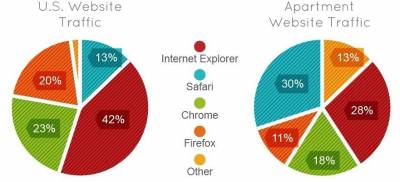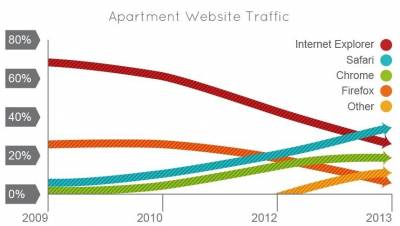Multifamily Blogs
Apartment Website Traffic Thwarts National Averages
Apartment Website Traffic Thwarts National Averages
 Just this month, Safari celebrated its 10 year anniversary as Apple Inc.’s landmark web browser for the Mac operating system. Since it was first released in 2002, Safari has taken over an admirable 13 to 15 percent of the U.S. market, through its use of products like Apple’s MacBook, iPad, and iPhone. But overall, Internet Explorer (IE) has managed to sustain its 13-year reign as America’s most widely used web browser.* However, when you narrow-in on web traffic to apartment websites, these distinctions do not hold true.
Just this month, Safari celebrated its 10 year anniversary as Apple Inc.’s landmark web browser for the Mac operating system. Since it was first released in 2002, Safari has taken over an admirable 13 to 15 percent of the U.S. market, through its use of products like Apple’s MacBook, iPad, and iPhone. But overall, Internet Explorer (IE) has managed to sustain its 13-year reign as America’s most widely used web browser.* However, when you narrow-in on web traffic to apartment websites, these distinctions do not hold true.
The people who are visiting apartment websites display a far different manner than the average web surfer. In addition to this month being Safari’s 10th Birthday, it is also the month that Safari surpassed Internet Explorer as the most used browser by visitors to ProspectPortal. Of the approximately 7 million visitors to apartment websites we monitored over 30 days, 30% were on Safari compared to 28% on Internet Explorer.

Okay, granted, it’s only a 2% difference. But looking at a cross section of apartment website traffic, it’s largely defiant of national averages. This brings up a lot of questions about who prospects are, how they’re discovering multifamily communities online, and what this means for the future of multifamily technology.

Apple, P.C., and Overdone Stereotypes
If you weren’t aware of it before, the elite phenomenon that is the Mac user was strongly communicated when Apple launched its “Get a Mac” campaign with a series of “I’m a Mac, I’m a PC” commercials from 2006 to 2010, which had a broad impact on the company’s brand identity. [This is where we would insert an analysis of 1984 if we remotely thought it worth your time.]
The fact is, people who own Apple products are a unique demographic. Statistically, they’re younger, living in urban areas, and are 95% more likely than PC users to enjoy indie films. I’m not suggesting that you go and outfit your entire marketing strategy exclusively to reach Apple customers; I just think this data is further evidence of how Millennials constitute a commanding presence in the rental market, and will only continue to do so in the coming years. While the extent to which browser usage reflects the character of our consumer demographic is admittedly inconclusive, we can confidently assert its connection to the rise of mobile browsing.
Mobile Traffic
More than anything else, Safari has become the most-used browser by visitors to apartment websites because of iPhone and iPad use. Numerous indicators which have surfaced in the past year have shown a marked shift in how people are searching, finding, and interacting with information from their mobile devices. Most of you are already aware that prospects are visiting your site from a smartphone or tablet, you may not know that they do so in even greater numbers than national averages. While the national average for mobile web traffic stands around 10%, mobile web traffic to apartment websites is triple that, at 33%. Good. Gravy.

Online Compatibility and Inclusivity
Long-term implications for our industry are clear: We need to allow ourselves to be found across the diversity of mediums that prospective residents use in their search. Mobile sites are a must. And not just a homepage: guest cards, unit search tools, work orders, and payments too. Desktop sites need to be just as glamorous on Safari or Chrome as they are through FireFox or IE. Our conception of SEO has to expand beyond the traditional Google search, to mobile local search and third party apps. As the market continues to evolve at a pace more rapid than ever before, industry technology should strive to be at the forefront of online consumer activity.
*While Google Chrome did overtake Internet Explorer in worldwide use last May, IE has remained the most popular browser in the U.S. since approximately 1999.

